10
MOVE
Why exercise? Have you ever wondered how did formal exercise or movement begin and why? Since the beginning of time it was necessary for humans to use their bodies for transportation, for physical work, to fight, to run from predators, to climb; we had to move to survive.
If we take a journey back in time to the days of the Roman gladiators, it becomes apparent why the gladiators started training specifically to get fitter, faster, and stronger—it was all about survival. For over 650 years the gladiators and their trainers were some of the first to understand training for optimal strength and elite performance. Today it is not necessary to train like the gladiators of our past, but as our demands continue to increase at a rapid pace, it becomes increasingly necessary to move daily for greater health, performance, and to build our capacity.
When I (Chris) entered Michigan State University as an exercise physiology graduate student in the early 1980s, my class schedule included the basic sciences such as anatomy, chemistry, and physiology. Then came my first exercise physiology class, and it was a game changer for me. Exercise physiology is the science of speeding up the processes that occur in the human body under stress and under demands, and of the acute responses and chronic adaptations that occur in the human body and mind under a variety of taxing conditions. I became fascinated at how the body adapts under the right training conditions. Given the right formula of movement, adequate rest, and proper nutrition, the mind and body will adapt and get stronger; bottom line, your ability to handle more under greater demands increases—your functional capacity expands!
On the opposite side of the spectrum, I was shocked by how quickly the human body can also break down with too much or too little movement. Did you know that too much movement could also break down the mind and body? As physical and emotional demands exceed capacity, stress hormones such as epinephrine and cortisol may quickly rise, leading to a decline in your building hormones—growth hormone and testosterone. These building hormones are essential for growth and repair. Did you also know that after only 14 days of complete bed rest, the human body loses over 50 percent of its functional capacity? The human body is magical in its ability to heal itself and get stronger with the right formula of resting, eating, and moving!
Exercise Is Good for You
By now almost everyone knows that regular movement or exercise is good for you. We will use movement or exercise in the same context throughout the rest of this chapter. The surgeon general reports that a sedentary lifestyle carries the same risk as smoking, high blood pressure, type 2 diabetes, or an imbalanced cholesterol profile. The research on the benefits of daily movement is overwhelming; in addition to making people happier, daily exercise improves mood, increases energy and engagement, improves sleep, decreases stress, improves heart health, decreases the risk of cancer and type 2 diabetes, improves bone health, keeps weight under control, improves strength and flexibility, improves sex life, increases brain power and memory, boosts the immune system, improves digestion—the list is long and will continue to increase.
The number-one reason we want you to move your body on a daily basis is how it can make you feel during and after exercise. Your mind becomes clear, your body feels loose and relaxed, and you feel energized and alive. Have you ever had a bad day, lots on your mind, too much stress, nothing seems to be working? Then you move your body and you feel refreshed and energized? Movement washes your brain; no longer do things bother you as much, your energy is up, and you feel great! Don’t take us the wrong way; we want you to look fit and trim. But it is the experience and feeling you get when exercising that keeps you going back. Most people keep coming back to exercise because they enjoy the process—finding enjoyment in movement is critical for long-term success and sustainability!
What Is Holding You Back?
If daily movement or exercise came in pill form, it would be the most prescribed medication in the world! Yet, even with all this knowledge, research, and promotion, people around the world are moving less. Given everything we know, why are we not exercising or moving more? Based on our 30-plus years of health and fitness consulting, speaking around the world, and talking with seminar attendees, friends, family, physicians, and colleagues, we believe there are five major reasons why many people are not exercising on a regular basis: values and beliefs, lack of knowledge, insufficient time, not enjoying the process, and no developed rituals.
1. Values and Beliefs
We all have different values and beliefs in all aspects in our lives. Values differ from beliefs. You may value your health but believe you need to spend hours in the gym to become healthy or need lots of cardio to lose weight. For a good portion of our society, exercise is low on the priority list. For many it is not even on the radar screen. We believe most people recognize exercise or movement is a good thing, but something is holding them back. They may feel intimidated, uncomfortable with their body, or fearful they may fail.
Exercise can be magical and life changing. Exercise can improve your ability to move; prevent injuries; decrease aches and pains; decrease stress; improve your fitness, strength, and flexibility; improve your mood and mental clarity; increase your energy; help you sleep better; and improve your health. If you polled a group of people, most would say their health is of great importance to them. They value their health, and why not? When you don’t have your health, you don’t have much!
How valuable is your health to you? If you believe your health is important to you, what are you willing to do to maintain or improve your health? Make daily movement or exercise a priority in your life. Value your health and believe you are worth it!
2. Lack of Knowledge
Many people lack knowledge about what exercises or movements to do, how to start, how much exercise is enough, and most importantly how to get your exercise plan going. You might want to challenge me. You might be thinking, “Are you kidding me? Everywhere I look there are books, magazines, videos, websites, podcasts, webinars, and infomercials dedicated to exercise.” Just like nutrition, there is so much information, good and bad, that people are overwhelmed. Many people are confused about whether to do high- or low-intensity cardio to lose weight and what specific strength training exercises will sculpt or shape a certain body part. What types of exercises can I do if I have bad knees, pain in my shoulder, chronic back pain, or type 2 diabetes? What exercises should I avoid? What exercises would be beneficial? Do I have the correct exercise technique?
Having the right knowledge will allow you to pivot on demand. This is one reason we recommend hiring a health and fitness coach to help educate and guide you on developing an exercise or movement plan that works for you. Whether you have a bad back or pain in your shoulder, or want to lose weight, learn how do a correct push-up, improve your numbers, or get into the best shape of your life, there are many terrific health and fitness coaches to help you reach your goals.
3. Insufficient Time
Time is a big issue for almost everyone. We want to make this point extremely clear: you can never out-exercise a poor diet! Most people do not have to spend large amounts of time to stay healthy and get into good shape. If you are training for a triathlon, marathon, or the Olympics, then, yes, you do have to invest large amounts of time to reach your goals. If your goal is to build your capacity, get healthier and in better shape, you will get the most out of your exercise program and achieve your goals if you adjust the frequency, quality, and amount of time you schedule for exercise.
At the beginning of each new year, we see so many people desperately trying to get in better shape. “This is my year!” One of the biggest mistakes most people make is believing that the more time they spend on exercise, the greater their results will be. Spending more time on the treadmill or in the gym does not necessarily add up to greater results. This is a huge mistake that we believe is a large reason why most people slowly abandon their exercise programs: it takes up too much time, making it almost impossible to sustain. We are not saying you can’t have greater focus and intensity at certain times of the year with your REST, EAT, and MOVE plans, but is this something that you can sustain? Do you want to run a sprint or a marathon? We want you to think of movement or exercise as compound interest—your goal is to deposit into your health bank account on a daily basis. How can you incorporate daily movement into your already busy life? Can you carve out 10 minutes each day for the rest of your life to devote to daily movement? We want you to get into a mindset that you need to move your body every day. The human body is designed to move on a daily basis. Your time is precious and you don’t need to spend lots of time exercising—the key is moving your body every day so you keep building up your health account!
4. Not Enjoying the Process
We have become a society that wants everything now. We seek instant gratification. Many of the wonderful benefits from daily movement come later, in the form of delayed gratification. Lowered blood pressure, balanced cholesterol, lower body fat, improved fitness, greater strength and flexibility, a better night’s sleep, stronger bones—you don’t reap all of these benefits overnight. There have been many times when we just don’t feel like moving our bodies; we are busy or tired. We have all the excuses too. When we feel like this, we focus on how we will feel during the middle of the exercise activity and how we will feel when we are done exercising. For us these are two powerful motivators. In the middle of our exercise routine, our hearts are pumping, the body is sweating, energy has increased, and the body feels alive. After exercise, energy is high, the mind is clear, the body feels loose, and mood is great. The feelings from exercise are priceless.
The most difficult time for many is just getting started—we call this the three-minute rule. In most cases after three short minutes, energy begins to improve, your brain becomes clear, your heart rate begins to climb, and the benefits continue to pile up!
One of the key motivators for developing a sustainable exercise program is finding movement activities you enjoy—enjoying the process is the gold nugget most people overlook. Walking, running, biking, swimming, playing tennis, yoga, Pilates, skiing, strength training, pickleball, paddleball, playing basketball, playing soccer, dancing, surfing—finding a movement activity you enjoy is paramount to your success! We believe teaching people how to enjoy moving their body is essential for sustainable movement. If people don’t enjoy their movement activities, they most likely will not continue. Many people have never experienced the joy of learning how to use their body!
We once trained a couple. The woman loved coming to the gym and working out, but her husband did not feel the same way. He did not like coming to the gym. We kept asking him is there an activity or sport he would like to try? He said yes, “I would like to learn how to play basketball.” At age 73, this man had never played basketball before. The next day we went to the gym and rolled out the basketballs. We showed him how to dribble, pass, and shoot layups; he even took a few three-point shots and crazy as it sounds, he made his first shot from behind the arch! The laughter between him and his wife was heartfelt. We developed a plan that increased his capacity on the court; he worked on his balance, strength, flexibility, and agility. He now had a purpose for his workouts and most importantly enjoyed the process. Learning how to enjoy the process can be magical!
5. No Developed Rituals
What is a ritual? A ritual is something that becomes part of you, like your DNA. A behavior starts as a focused thought, and then moves into a habit, and over time may become a ritual. A ritual is something you do on a regular basis without much thought. This is one reason it is so difficult for people to quit smoking. It has become a powerful ritual. You have a cup of coffee—you have a cigarette. You read the newspaper—you have a cigarette.
Brushing your teeth, taking a shower, getting dressed, putting your shoes on the same way each and every day are powerful rituals. If you are not moving your body on a daily basis how then do you develop an exercise ritual? What do you want? Why do you want it? How are you going to do it? Start slowly and focus on two factors, time and enjoyment. This is one reason we have most of our clients walk for 10 minutes and do a series of yoga poses for five minutes every day. It does not take much time; incorporates balance, strength, flexibility, and fitness all rolled into one; can be done virtually anywhere; and makes clients feel great. We can always add more exercises or movement activities later, but first we want them to develop some movement rituals that will last. Imagine moving your body on a daily basis for the rest of your life. Developing healthy rituals is one of the keys to a healthy and happier you.
Movement and Weight Loss
Before we jump into the specific exercise portion of the chapter, we want to discuss weight loss and the mindset associated with successful weight loss. Many people we encounter at On Target Living have a specific goal of losing weight and believe that they will lose weight if they exercise or just move more. The truth is, it is not that simple. You will burn more calories and maybe lose a few pounds by moving more, but many people who exercise regularly are still overweight due to their poor nutritional habits. Many people still believe that long-duration, low-intensity cardiovascular exercise in the best method to lose weight, thinking the more calories they burn, the more weight they will lose. Unfortunately for many, spending more of their precious time in the pursuit of losing weight is not efficient or effective.
The latest research has shown that higher intensity bursts of cardiovascular exercise is much more efficient and effective in stimulating the lean hormones that aid in weight loss. However, although high intensity cardiovascular can be effective in getting the body in better shape, it can be very difficult, unpleasant, and extremely challenging to sustain. This type of high-intensity training is not much fun, and most people will not enjoy the process, which leads to greater stress. A more successful approach to movement or exercise takes into account enjoyment and learning how to pivot and perfect the activities you enjoy.
Chris’s Story
For over 30 years I have competed in natural bodybuilding. My first contest was in 1985, and have competed in 10 since with the latest being in 2013. Every year I compete people ask, “What type of exercise program do you do to get into that type of shape on stage”? I would tell them that my workouts are relatively the same all year long. My intensity and focus is greater prior to competition, but my workout routine does not change a great deal prior to the contest. But nutritionally everything tightens up. I fast for over 12 hours or more each night (7:00 P.M. to 7:00 A.M.), drink plenty of water, take my superfoods, and eat more frequently throughout the day. My portion sizes are smaller, and I eat in the center of the Food Target for three months before a competition. This is not the 80/20 rule, but the 99/1 plan. I enjoy the challenge and the process, but it is difficult to sustain long term.
Proper nutrition accounts for 80–85 percent of successful weight loss. Clean up your diet, move your body daily, get enough rest; this is the magic formula for sustainable weight control.
This is an example of the before and after (Figures 10.1a and 10.1b). The exercise routine is almost identical; the nutritional program is what tightens up. You can’t out train a bad diet.
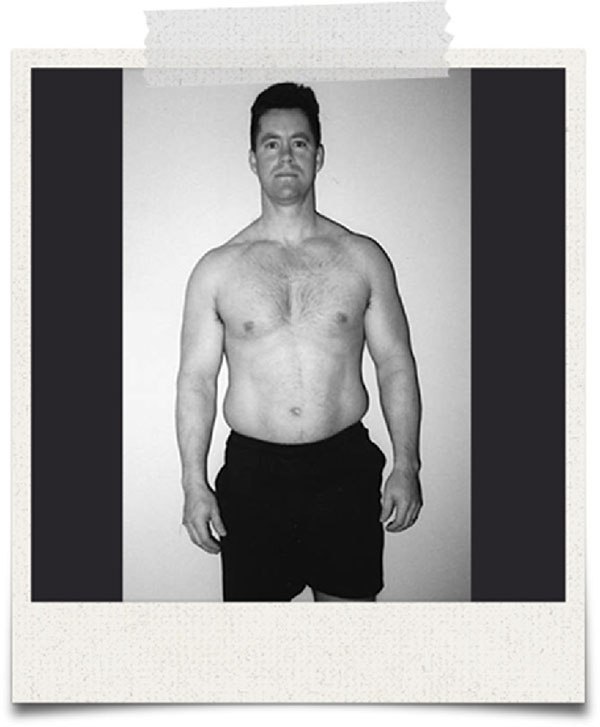
FIGURE 10.1A Chris Before (January 2002, age 45)
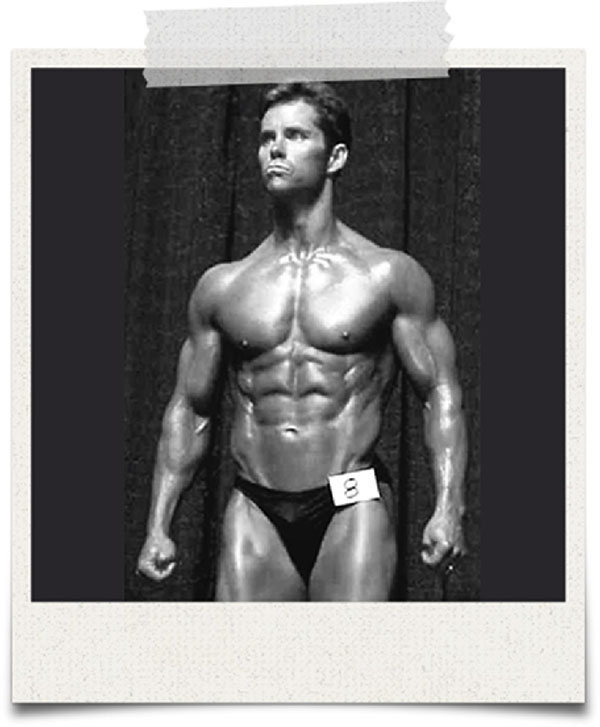
FIGURE 10.1b Chris After (April 2002, age 45)
New Movement Mindset
A few years ago on a family vacation in northern Michigan, we took a trip over to the Pierce Stocking Scenic Drive, the Empire State Building of sand dunes. This sand dune rises 450 vertical feet, straight up out of Lake Michigan. The view of Lake Michigan from the top is incredible; you are so high you feel as if you are looking out of an airplane. The sign at the top cautions any climber who is thinking of climbing down to Lake Michigan to think seriously about turning back due to the steepness of this sand dune and the fact that it may take multiple hours to get back up. The sand dune was so enticing—it was almost begging you to take the challenge and climb down to the bottom.
We all decided to take the plunge and climb down into this steep beast. The climb down was nothing but exhilarating! The sand was deep, and the dune was so steep that with each step you felt as though you could fly. We were all laughing like a bunch of little kids frolicking to the bottom. When we arrived at the bottom and all of us looked up, we knew why there was a severe caution sign at the top. As we looked back up the steep sand dune, you could see people everywhere; the sand was littered with people trying to make their way back up and many were not moving—they were just lying in the sand, totally exhausted. On the way down we did not notice the people lying in the sand; we were too busy laughing and enjoying the ride down. One by one we headed back up. The sand was deep and for each step we took, it felt like we were barely moving upward. The climb up was exhausting but we all felt a sense of accomplishment that we did it. Matt said to me, “Imagine, dad, if most people could complete this climb. How would this impact our spending on health care, our health, our performance, our capacity? What would our world look like if everyone moved his or her body on a daily basis?”
Rolling Back the Hands of Time
We don’t want to suggest that there is only one specific way to move your body, or that the exercises we discuss in this book are the only means to achieve the results you are seeking. Our recommendations are meant to be a jumping off point for someone new to exercise or a way to enhance those of you that are experienced exercisers.
Let’s begin by asking a few questions: Are you currently exercising or moving your body on a daily basis? How would you rate your current fitness level on a 1–10 scale? What would you like your current fitness to be? What type of investment would it take to accomplish your health and fitness goals? What type of exercises or movements do you enjoy? Do you have any injuries that are holding you back from activities you used to enjoy? Would you like to participate in these activities once again?
Start slowly, train smart, and choose ways to move your body on a daily basis that are fun, enjoyable, and repeatable. We have outlined a sequence of movement steps (Figure 10.2) that can create outstanding results and help us all turn back the hands of time.
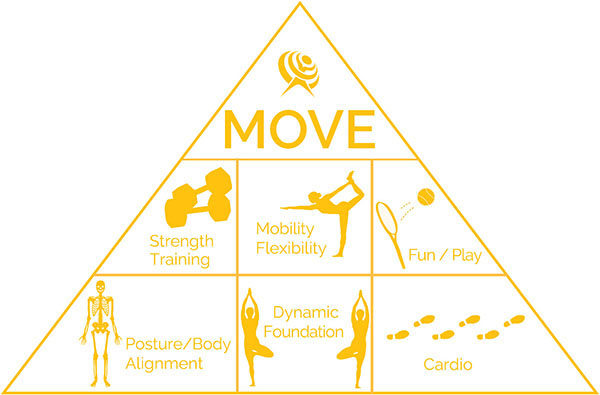
FIGURE 10.2 MOVE Methodology
MOVE Methodology
Step 1: Posture/Body Alignment
Step 1 begins with learning how to improve your posture and body alignment. Almost all muscular/skeletal problems begin with poor posture and an imbalance of our body alignment. When the body slowly gets out of alignment, many injuries start to show up. Back pain; foot, ankle, knee, and hip pain; neck and shoulder problems; and many more issues stem from poor posture and poor body alignment. For example, if you round your shoulders and drop your head forward while working on your computer, sitting at your desk, driving your car, walking, or using a cardiovascular machine or during strength training, the rotator cuff—the muscles that work in harmony moving the shoulder—can easily become impinged and damaged. When you sit up straight, elevate the chest, and drop the shoulder blades down and in, the space in the shoulder joint increases, allowing the rotator cuff tendons to easily glide back and forth, moving the shoulder in harmony with increased range of motion and no pain. The five key points for ideal posture alignment are the ear, shoulder, hip, knee, and ankle. (See Figure 10.3.)

FIGURE 10.3 Ideal Posture
We all get into movement patterns, and over time, certain muscles become shorter and many times stronger, while opposing muscles may become weaker. This can create muscle imbalances that lead to poor posture, an increase of injuries, pain, and a loss in mobility and flexibility. Training the nervous system with specific exercises can improve posture and body alignment. Here are two easy posture exercises that take seconds to perform and that you can do each and every day:
- Standing wall extension—Stand tall with your heels, butt, shoulders, and head against the wall and slowly raise your arms overhead. Do this three to five times.
- Standing upward dog and downward dog—Place your hands on your desk or wall. Keep your arms straight, stick your rear end up and out, and slowly stand up arching your back. Do this three to five times.
Let’s all begin to fight back in our battle against gravity by improving our posture. Paying attention to your posture and body alignment can go a long way in keeping the body healthy and performing at its best.
Step 2: Move Your Body Daily
We believe many people don’t move or exercise because they feel like they don’t have enough time. You don’t need a lot of time to improve your health, fitness, and performance. Think of movement or exercise as compound interest—you need to deposit every day into your health bank account. Take the stairs, stretch at your desk or at the airport, go for a walk, or do a set of body-weight squats or push-ups; even if you have just five minutes to move, do it! If your goal is to have more energy, increase your focus, improve your mood, then start moving. Remember, motion creates positive emotion! Changing your mindset to include moving your body evry day can reap great benefits over time.
Step 3: Flexibility and Balance
As we age our flexibility and balance can quickly disappear if we do not work at it. Can you easily touch your toes? Stand on one foot and hold for 10 seconds? What many people are missing in their daily movement or exercise plan is flexibility and balance. As your flexibility and balance improve, so does your ability to move with ease and grace. Aches and pains slowly start to disappear, and your body begins to feel more supple and young again. There are many wonderful exercises to improve flexibility and balance—the key is devoting just a few minutes each day working to improving your flexibility and balance. We have outlined a series of exercises that will improve your posture, flexibility, balance, and overall health and fitness in less than 8–10 minutes per day.
Dynamic Warm-Up (2 to 3 minutes)
We use the dynamic warm-up exercises at the beginning of all our exercise sessions (see Figure 10.4). The dynamic warm-up exercises cover the entire body, lubricate the joints, improve flexibility and balance, and are quick, taking less than two to three minutes to perform. Use slow and controlled movements and gradually increase the range of motion as you warm up.
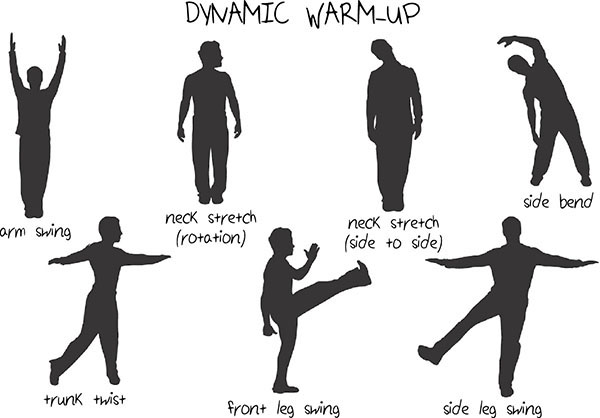
FIGURE 10.4 Dynamic Warm-Up Exercises
- Arm swing
- Neck stretch (side to side, rotation)
- Side bend
- Trunk twist
- Front leg swing
- Side leg swing
Foundation Exercises (5 to 6 minutes)
We call the foundation exercises the superfoods of movement. The foundation exercises are a series of yoga movements that can improve your posture, balance, flexibility, strength, and fitness, all rolled into a five- to six-minute movement routine (see Figure 10.5). Hold each movement for two to five seconds and focus on the proper form along with your breathing. Experiment, challenge yourself, make mistakes, and enjoy the wonderful benefits they can bring.
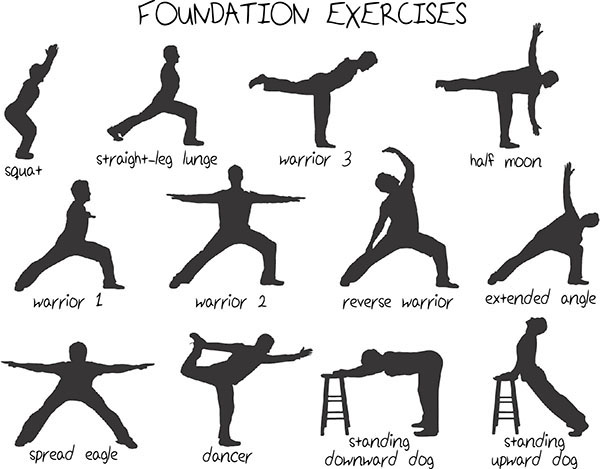
FIGURE 10.5 Foundation Exercises
- Centering squat
- Straight-leg lunge—warrior III—half moon
- Warrior 1—warrior 2—reverse warrior—extended angle—spread eagle
- Dancer
- Standing upward dog and downward dog
- Half-moon (against the wall)
Step 4: Strength Training
If there is one form of movement that can turn back the hands of time, it is strength training. The benefits of strength training include increased strength, increased bone density, improved mobility and functionality, improved posture, better balance, increased athletic performance, injury prevention, reduced stress, increased self-esteem, increased metabolism, weight control, improved overall health, and increased capacity. Strength training truly is the Fountain of Youth.
Strength training can be done using a variety of equipment such as free weights, kettlebells, resistance bands, machines, or your own body weight. Here are few guidelines to follow:
- Posture/body alignment—Begin each movement with a good foundation, and try to maintain good posture throughout each exercise. If your form begins to break down, stop the exercise or movement.
- Technique—Are you performing the movement correctly? If you are performing the exercise with poor mechanics, you may be reinforcing an unhealthy movement pattern. We highly recommend hiring a health professional to help you perfect your strength training movements.
- Progressions—There is more to strength training than repetitions, sets, and resistance. Allow your body time to adapt to your strength training exercises. As your body begins to adapt to your strength-training program, start making a few small changes in your program so your body stays challenged and continues to make adaptations. There are seven areas of progressions that you can change on demand. They include the:
- Number of exercises
- Number of sets
- Number of repetitions
- Amount of resistance
- Length of rest and recovery
- Speed of movement
- Stability and balance (e.g., lifting your feet in the air while doing a dumbbell bench press)
- Breathing—Your breath helps you monitor the intensity level of each exercise. As the intensity of the exercise rises, you may find you are starting to hold your breath. Try to maintain a consistent breathing pattern throughout all of your strength exercises.
- Perfect the ordinary—Imagine if you and everyone in your organization could do one perfect bodyweight squat and one perfect push-up; how fit would you be? How fit would your organization be? The key for staying healthy and fit is to focus on a few basic movements and perfect the ordinary.
Here are a few of our favorite strength-training exercises:
- Squat (bodyweight or dumbbells)
- Step back or step up
- Ankle-tubing side step
- Psoas hip raise (Tip: Helps with sciatic nerve pain)
- Push-up (modified or regular)
- Pull-up or lat pull-down
- Standing bodyweight row
- Standing shoulder press
- Standing flexion/extension
Step 5: Cardio
Cardiovascular exercise includes walking, hiking, jogging, biking, swimming, cross-country skiing—virtually any movement that is rhythmic in nature and gets the heart pumping. There are many benefits of cardiovascular exercise, including stress reduction, improved pH balance, improved cellular sensitivity, mood elevation, increased cardiovascular efficiency, improved blood pressure, improved blood glucose, cholesterol balance, and weight control. Bottom line: It helps you feel good and expands your capacity.
Here are a few guidelines to follow:
- Modality—Find a cardio movement you enjoy and add variety to your exercise plan. Do you enjoy swimming; walking; running; biking; playing tennis, paddleball, or basketball; skiing; taking a group fitness class; or using a cardiovascular machine or mini-trampoline? The key for sustainable fitness is finding an activity you enjoy.
- Frequency—Try to raise your heart rate two to six times per week.
- Duration—This is the big one: you can never out-exercise a poor diet. We find many people spend way too much time doing cardiovascular exercise in the hope of losing weight. Cardiovascular exercise is a very inefficient method to losing weight. All you need for improved health and greater capacity is 10–25 minutes of high-quality cardiovascular exercise. If you want to go on a long walk or bike ride, no problem, but get out of the mindset that you need to spend your precious time doing lots of cardio.
- Intensity—Cardio does not have to be painful to be beneficial. Get your heart rate up, and try to get a little uncomfortable; it’s okay to get out of breath, but cardio does not have to be extremely intense to be beneficial. Remember, the key for sustainable movement is enjoying the process.
Step 6: Play/Fun
We all need to play more and enjoy moving more. Play contributes to the cognitive, physical, social, and emotional well-being of kids and adults. Today more than ever before our society has become over structured, especially when it comes to play. Sit back and listen when people are free playing; you hear laughter. You can feel the joy flowing through the body; energy is high, people’s moods are elevated, and stress of our fast-paced world seems to disappear. Take time to play and experience the tremendous benefits you, your friends and family, and your organization can enjoy by playing more.
Developing a movement plan begins by recognizing the tremendous benefits daily movement can bring to you and your organization. Moving your body on a daily basis can have magical benefits to your body and mind. Make your movement plan enjoyable fun, play more, perfect the ordinary, and remember that motion creates positive emotion. Let’s get moving!
Figure 10.6 shows the exercise routines we help design for people.
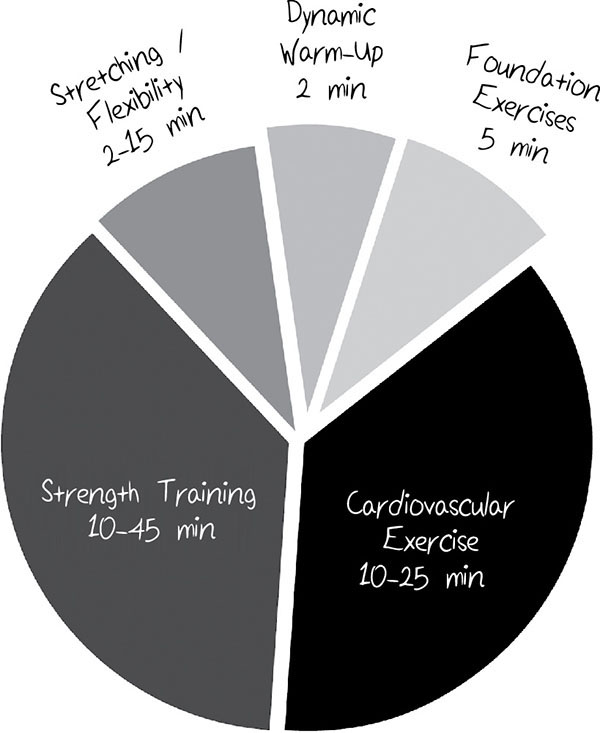
FIGURE 10.6 Sample exercise routine
Go Time
Now it’s time to take action, to start moving on a daily basis. As mentioned, there are endless ways to move the human body—the key is to find a movement activity you enjoy and get your body in motion. Remember, motion creates positive emotion! Also, there is no one right way to move your body; the key is daily movement and then try to perfect the ordinary! Following the MOVE methodology can guide you and build a sustainable foundation that can easily be implemented throughout your entire organization. Start slowly and continue to upgrade your exercise habits.